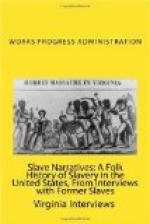“The black people never had no amusement. They would have an old fiddle—something like that. That was all the music I ever seen. Sometimes they would ring up and play ’round in the yard. I don’t remember the games. Sing some kind of old reel song. I don’t hardly remember the words of any of them songs.
“Wouldn’t allow none of them to have no books nor read nor nothin’. Nothin’ like that. They had corn huskin’s in Mississippi and Georgia, but not in Arkansas. Didn’t have no quiltin’s. Women might quilt some at night. Didn’t have nothin’ to make no quilts out of.
“The very first work I did was to nurse babies. After that when I got a little bigger they carried me to the field—choppin’ cotton. Then I went to picking cotton. Next thing—pullin’ fodder. Then they took me from that and put me to plowin’, clearin’ land, splittin’ rails. I believe that is about all I did. You worked from the time you could see till the time you couldn’t see. You worked from before sunrise till after dark. When that horn blows, you better git out of that house, ’cause the overseer is comin’ down the line, and he ain’t comin’ with nothin’ in his hand.
“They weighed the rations out to the slaves. They would give you so many pounds of meat to each working person in the family. The children didn’t count; they didn’t git none. That would have to last till next Sunday. They would give them three pounds of meat to each workin’ person, I think. They would give ’em a little meal too. That is all they’d give ’em. The slaves had to cook for theirselves after they come home from the field. They didn’t get no flour nor no sugar nor no coffee, nothin’ like that.
“They would give the babies a little milk and corn bread or a little molasses and bread when they didn’t have the milk. Some old person who didn’t have to go to the field would give them somethin’ to eat so that they would be out of the way when the folks come out of the field.
“The slaves lived in old log houses—one room, one door, one window, one everything. There were plenty windows though. There were windows all [HW: ?] around the house. They had cracks that let in more air than the windows would. They had plank floors. Didn’t have no furniture. The bed would have two legs and would have a hole bored in the side of the house where the side rail would run through and the two legs would be out from the wall. Didn’t have no springs and they made out with anything they could git for a mattress. Master wouldn’t furnish them nothin’ of that kind.
“The jayhawkers were white folks. They didn’t bother we all much. That was after the surrender. They go ’round here and there and git after white folks what they thought had some money and jerk them ’round. They were jus’ common men and soldiers.
“I was not in the army in the War. I was right down here in Union County then. I don’t know just when they freed me but it was after the War was over. The old white man call us up to the house and told us now we was free as he was; that if we wanted to stay with him it was all right, if we didn’t and wanted to go away anywheres, we could have the privilege to do it.




